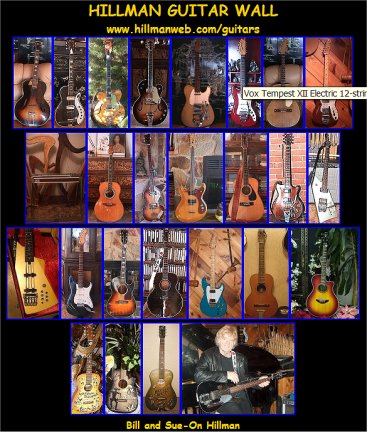
Hillman Guitar No. 7
Fender Malibu Flat-Top Acoustic
Serial No. 068838
1968
www.hillmanweb.com/hillgt07.html
Fender acoustic instruments have seldom impressed me. However, this palomino-coloured gem from Fender is one of the best looking, best playing and best sounding acoustic guitars that Fender ever made.In 1968, Sue-On and I moved to Brandon for three years to attend university. We lived with Sue-On's brother Kenny and his wife Rebecca, in a basement suite they had just completed in their west end home. To help pay tuition costs we played in Brandon pubs -- every night, from Monday through Saturday -- and were up every morning for 8:30 classes. The long hours of performing necessitated the constant learning of new material. Since we left our equipment set up in the downtown hotels or halls: Brandon Inn's Viking Room, The Cecil, The Beaubier, The Prince Edward, Brandon University, etc., we soon saw the need for having a good acoustic guitar for working on material before the shows.
Enter the Fender Malibu, purchased second-hand, with case and pickup, for $100 from Keith Dodds, a Brandon musician. Actually, Keith now works for Leech Printing where we've had most of our album covers, inserts and promo pics done over the years. We've always preferred to have work like this done locally so that we have complete control over graphics design and production and their printing offices and plant are a stone's throw from our Brandon home. Sadly, our long relationship with this company soured when, during a house-cleaning binge, they threw out our entire two decade file of original artwork, family history books, design layouts, photos, and costly colour separations. The loss has left an irretrievable gap in the career bio that you are now reading.
This Malibu model features a unique Fender pickup but the type of stage work we did at the time, and the fact that we have always worked as a trio, made it difficult to work it into our stage sound. However, over half of the 50-odd original songs we've recorded were written on this guitar. I also used it for acoustic rhythm tracks on our recording sessions until I bought an Ovation Legend around the time of the Volume 6 album. For many of the songs I replaced the three bottom strings with treble strings for a Nashville HiBass tuning. The guitar and its case have the dubious distinction of being pressed into drum service as we used them to pound out the backbeat on a few of our recorded songs.
Up until our last album I've done all of the guitar tracks at our sessions. Usually, to get the right feel for what we wanted and to lead the rhythm section, I would sing a rough work track while playing a Tele. Once we had the bed tracks down -- Sue-On did nearly all of the drums and percussion on our sessions -- I would add a left normal acoustic track and then go back and add a hi-bass acoustic track to the right. The stereo effect from these different acoustic sounds sounded great in the control room, although by the time we had finished the mix the effect was usually buried beneath the other instruments. Oh, to re-record all of our original material using modern recording techniques ... sigh!
Fender Malibu
Ref: Harmony Central Guitar Data Base
Manufactured in the USA by Fender Instruments
Users' Rating:
Features: 7
Sound: 8.7
Action, Fit, & Finish: 8.7
Reliability/Durability: 9.7
Customer Support: 1
Overall Rating: 8.7These were made from 1965-1969. Fender came out with another Malibu model in the '80s
which is not the same guitar. The Malibu was very popular in the 60s but don't seem too popular today. Some of the people who used them professionally were: Steve Stills, Michael Jackson, Johnny Cash, Joan Biaz, Arlo Guthrie, Gerry Garcia, Eric Clapton and many others.They have a big headstock and maple bolt on Stratocaster-style neck (4 bolt) that looks and plays like an electric Fender, probably the reason that it was never very popular with acoustic players. It is, however, the electric player's dream acoustic with great action. It is a small body flattop with spruce top and mahagony back & sides. There is a truss rod adjustment at the heel of the neck and it has typical Fender "F" type slotted tuners. Fender made other bolt on neck models, most with names of cities on the headstock.
14 7/8" wide, mahogany back and sides, single bound top, 25.5" scale, dot fingerboard
inlays, sunburst or mahogany or black finish. Introduced in 1965. Discontinued 1971. The Villager is the 12 string version of the Malibu.Reference: Vintage Guitar Website
All Fender acoustic flat top guitars have 2 screws in the pickguard, 6 on-a-side tuner configuration (except the Classic and Folk), and a bolt-on neck with a metal neck plate on the back. For the most part serial number follow the electric models. BUT in some cases, they do not.Fender basically took the design principles that made their electric guitar models famous, and applied them to their acoustic flat top guitar models. Unfortunately, this made for bad sounding and horrible looking flat tops. Fender flat tops have no vintage collectibility. The Wildwood and Brazilian rosewood models are visually interesting and cool to look at (especially the funky colored Wildwoods), but have no real vintage value. Fender acoustics are a footnote in Fender's history. A lot of people ask about them because they are readily available for a cheap price.
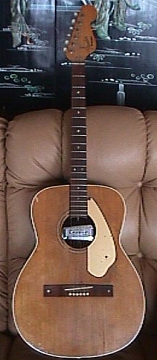
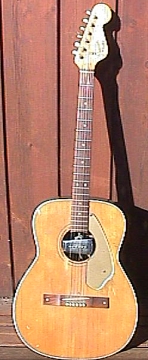
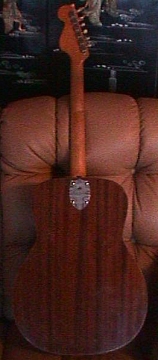
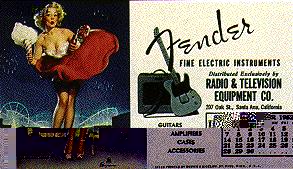

 \
\
